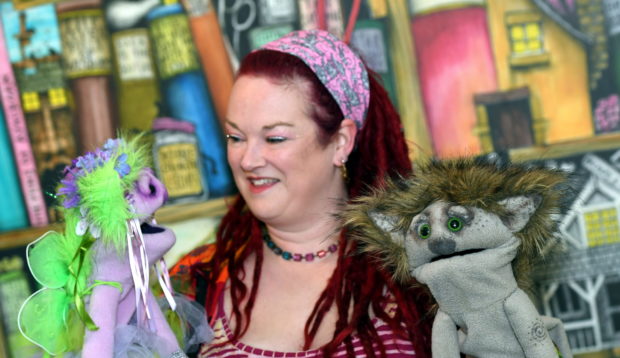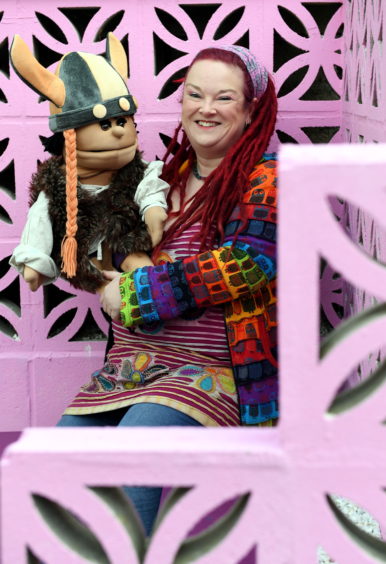From the moment we can talk, we tell ourselves stories. The rambled imaginings of childhood, fuelled by magic and curiosity for the world.
Tales of who we are and where we have been, storytelling cares not for borders or difference in tongues.
It cradles culture and shapes generations, with tales handed down from wise grandparents to wide-eyed youngsters.
Everyone has a story. It is ingrained in who we are.
But whether the words flow freely, leaving pictures in their wake, or come to a stagnant stop, well, that depends on the teller.
Pauline Cordiner can bring characters to life in seconds – her face an ever-changing mask of colourful expressions.
The 44-year-old, who lives in Garthdee, joined The Grampian Association of Story Tellers (GAS) in 2003 after seeing an advert in the paper.
She is now chair of the group, which provides workshops for storytellers, ballad classes and mentoring.
Pauline also travels across the north-east and beyond for events such as Spectra, and goes into schools and care homes.
She believes there is untapped potential for storytelling across the north-east, and says tales can be told in all manner of ways.
Here, Pauline explains why “once upon a time” is just the beginning.
“I used to be an environmental chemist, I worked for Shell.
“Storytelling was my hobby until it was redundancy time.
“I remember thinking to myself that it wouldn’t be the worst thing if I was made redundant. It would give me the opportunity to carve out a career as a storyteller.
“I also believe that those two different areas of my life, storytelling and science, can exist quite nicely together.
“There doesn’t seem to be that much connection between science and art, but there absolutely should be.
“I find it quite easy to balance the logical part of my brain and the art side.
“I often break a story down into five bullet points. Then I picture it like a film playing out in front of me.
“When I am learning a story, I often go to sleep on it.
“That’s my way of sequencing it.
“By the time I actually tell the story, I become someone else.
“Not every storyteller does.
“You can tell a story as if you are reading Enid Blyton, and it is no less wonderful.
“I’ve always created characters and done stupid voices, even when I was a child.
“My mum never discouraged me, and I always tell stories to my own daughter.
“I don’t read from a book when I have an audience, because that means your face is on the page. You lose the eye contact and the facial expressions.
“There’s this quote that says: ‘Reading a story from a book is like looking at a musical instrument in a glass case in a museum. That instrument doesn’t exist to be looked at. It exists to be played and enjoyed.’
“There is this preconception that stories are for children.
“Stories are actually for everybody.
“There have been moments in care homes.There was this elderly gentleman who was wheeled in. At the end of the story, he looked up and said: ‘In my house it was butteries, not rowies.’
“Everyone turned around and looked at him in shock.
“He hadn’t spoken in months, and he started telling people about flying a bomber.
“My dad worked in the shipyard after the war, and there had been this awful incident.
“He only told me the story just before he died, as if he needed to rid himself of it.
“Look at people around the world who did not say a word about their experience of concentration camps, then they started telling their stories and those stories had such an important part to play.
“I cannot imagine a world without stories.
“No matter how many times a story is told, it is given new life and meaning.
“There was a big revival of storytelling in the Sixties, but people have always told stories.
“I think the term in itself is misused in so many ways – it isn’t reading out of a book.
“If you go into a pub, there’ll be a bunch of old men sitting around, and they’ll half tell you a story.
“Then they’ll say: ‘Oh, you see Dave over there… well he can tell you.’
“I always tell children that they are already storytellers, it is ingrained in them.
“People seem surprised that storytelling groups exist, but it is such an obvious thing in my eyes.
“It is an amazing world to be immersed in.
“I like folk tales – they are the people’s stories. And I love a witty story.
“Stanley Robertson, who was honorary president of GAS, had this way of describing storytelling.
“He called it the maisie, which is another way of saying the muse.
“It’s a way of describing that moment when your audience is hanging on your every word.
“Stanley would say: ‘You have breathed in the maisie and you are bringing it out bonnie.’
“I don’t really see what I do as a job, because you get to see people light up.
“That’s an incredible thing.”
For more information about GAS, visit grampianstorytellers.wordpress.com











